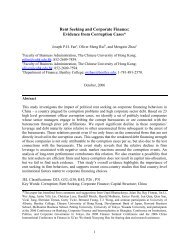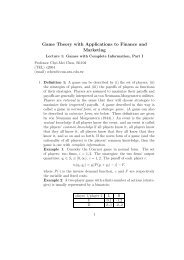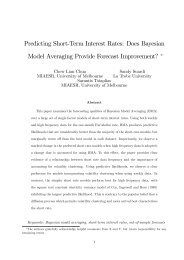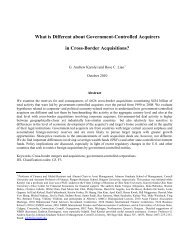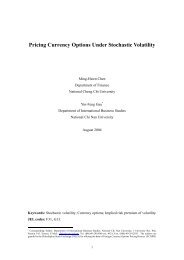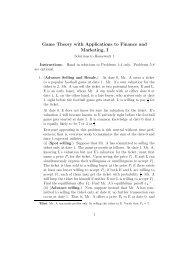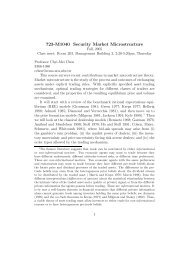Game Theory with Applications to Finance and Marketing
Game Theory with Applications to Finance and Marketing
Game Theory with Applications to Finance and Marketing
Create successful ePaper yourself
Turn your PDF publications into a flip-book with our unique Google optimized e-Paper software.
Let the set of correlated equilibria be A. Then,<br />
A = {(a, b, c, d) : a + b + c + d = 1, a, b, c, d ≥ 0, a, d ≥ b, c.}.<br />
Note that all NE’s are contained in A, 4 <strong>and</strong> if (a, b, c, d) is a <strong>to</strong>tally<br />
mixed strategy NE, then it must satisfy<br />
a<br />
b = c d , a<br />
c = b d .<br />
16. Example 6. In a duopolistic industry two risk neutral firms (i.e.<br />
expected profits maximizers) that produce respectively products A <strong>and</strong><br />
B are faced <strong>with</strong> three segments of consumers:<br />
Segment Population Valuation for A Valuation for B<br />
L A α V 0<br />
L B β 0 V<br />
S 1 − α − β v v<br />
where 0 < β ≤ α < α + β < 1, <strong>and</strong> 0 ≤ v < V . These segments are<br />
loyals <strong>to</strong> the two firms <strong>and</strong> the switchers who regard the two products<br />
as perfect substitutes. We have assumed that a loyal is willing <strong>to</strong> pay<br />
more than the switcher <strong>to</strong> obtain the product.<br />
For simplicity the two firms have no production costs, <strong>and</strong> they compete<br />
in price in a simultaneous game. We shall demonstrate the equilibrium<br />
dealing behavior of the two firms.<br />
17. First, we look for a pure strategy NE. Suppose (p A , p B ) is an equilibrium.<br />
There are 3 possibilities: (i) p A , p B > v; (ii) p A , p B ≤ v;<br />
<strong>and</strong> (iii) max(p A , p B ) > v ≥ min(p A , p B ). For case (i), we must have<br />
p A = p B = V , <strong>and</strong> for this <strong>to</strong> be an NE, we must require<br />
βV ≥ (1 − α)v, αV ≥ (1 − β)v. (1)<br />
4 There are 3 NE’s for this game, <strong>and</strong> they are respectively<br />
(a, b, c, d) = (1, 0, 0, 0), (a, b, c, d) = (0, 0, 0, 1), (a, b, c, d) = ( 1 4 , 1 4 , 1 4 , 1 4 ).<br />
15



